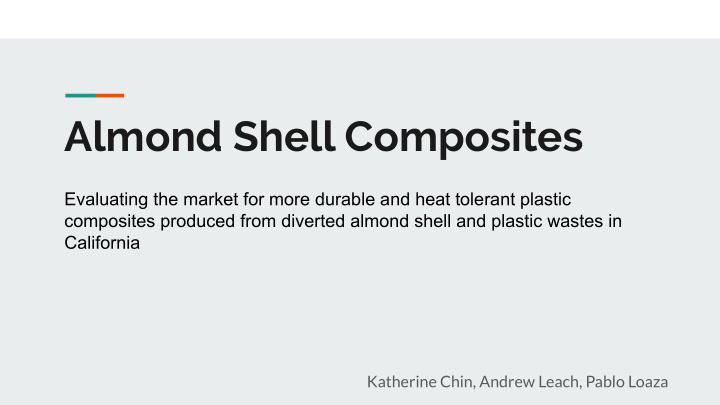



Almond Shell Composites Evaluating the market for more durable and heat tolerant plastic composites produced from diverted almond shell and plastic wastes in California Katherine Chin, Andrew Leach, Pablo Loaza
Final Statement Problem Statement We are students in Geography, Initial Statement Environmental Planning, and Atmospheric Sciences working with the USDA to Finding commercial applications for the determine the techno-economic feasibility of creation of alternative plastics from diverted bringing torrefied almond shell composites to landfill plastic and almond shell waste. the market. The goal is to effectively divert plastic and almond shell waste from landfills to improve material properties of degraded plastic with the torrefied almond shells, creating more durable and heat tolerant plastic pellets that plastic manufacturers can use in place of virgin plastic or recycled plastic for consumer product production.
Background Over 80% world’s almonds produced in ● California Over 1.5 billion pounds almond shells produced ● per year With an increase in consumption and limitations ● of dealing with plastic waste, these wastes would end up in the landfills and potentially lead to environmental pollution.
Research Findings ● Manufacturing bioplastics can lead to considerable energy and greenhouse gas savings, but it is important to consider bioplastics waste disposal. Mechanical recycling is the best solution for bio-based product disposal (Piemonte 2011). ● Most bioplastics end up in landfills, where they cannot break down. Landfills are absent of oxygen and light, which are needed for organisms to break down bioplastics. They (Grand View Research 2018) remain in their manufactured forms, and leech out methane into the atmosphere (Baker 2019). Global biocomposite market size: $16 billion in 2016 ● ● Cost of production bioplastics can range ● Expected to grow 12.5% annually by 2025 between $4-16 per kg. $3-5 per kg to be (Grand View Research 2018) commercially viable (Roland-Holst 2013).
Stakeholder Analysis
Problem Tree
Moving Forward Life Cycle Assessment ● Wastewater produced from treating the diverted plastic ○ End of Life analysis for these products ○ Will it successfully offset environmental impact? ○ Determining total cost of production and manufacturing ● What are the incentives to better manage waste produced from almond shell composites ● production?
Recommend
More recommend